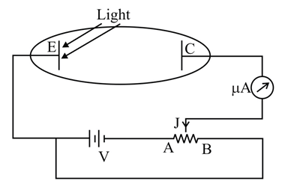Photoelectric Effect
Important Questions on Photoelectric Effect
The electron in a hydrogen atom jumps back from an excited state to ground state, by emitting a photon of wavelength where is Rydberg's constant. In place of emitting one photon, the electron could come back to ground state by
A point source of light is used in an experiment of photoelectric effects. If the distance between the source and the photoelectric surface is doubled, which of the following may result?
A photosensitive surface is irradiated with light of wavelength , the stopping potential is . When the same surface is irradiated with the light of wavelength , stopping potential is . The ratio of threshold wavelength and the is . Write the value of .
A photo-sensitive plate is placed at from a point source of light of and a power output of . The light falls nearly normally to the plate.The approximate number of photons reaching the plate per square metre per second is . Find , assuming the photon efficiency of plate to be .Use : Area of plate .
In a photoelectric experimental setup ultraviolet light of wavelength is incident on emitter plate . The work function of the emitter plate is is a uniform wire resistor having length . Resistance of the wire is and the emf of the battery is volt. The sliding contact can be moved along the wire . When the sliding contact is placed at end of the wire resistor the micro-ammeter shows a reading of . Assume that photoelectric current is very small compared to the current through the cell. Find the reading of the ammeter (in ) when the slider is moved to end of the wire.

The threshold frequency for a certain metal is . If light of frequency is incident on the metal, then the cut-off voltage for the photoelectric emission is approximately is . The value of is
Electrons are emitted with kinetic energy from a metal plate by an irradiation of light of intensity and frequency Then, which of the following will be true?
Photoelectric effect supports quantum nature of light because
The velocity of the most energetic electrons emitted from a metallic surface is doubled when the frequency of the incident radiation is doubled. The work function of the metal is
A metal surface of work function is irradiated with light of wavelength . The retarding potential required to stop the escape of photo-electrons is
The maximum wavelength of radiation that can produce photoelectric effect in a certain metal is . The maximum kinetic energy acquired by electron due to radiation of wavelength will be
When the light of frequency $v_{1}$ is incident on metal with work function (where the photocurrent falls to zero at a stopping potential of If the frequency of light is increased to , the stopping potential changes to . Therefore, the charge of an electron is given by
When photons of energy- fall on an aluminium plate (of work function is ), photoelectrons of maximum kinetic energy are ejected. If the frequency of the radiation is doubled, the maximum kinetic energy of the ejected photoelectrons will be
Photons with energy are incident on a cathode in a photoelectric cell. The maximum energy of emitted photoelectrons is . When photons of energy are incident on no photoelectrons will reach the anode , if the stopping potential of relative to is
On a photosensitive material, when the frequency of incident radiation is increased by , the kinetic energy of emitted. photoelectrons increases from to . The work function of the surface is
When light of falls on a metal surface, the maximum kinetic energy of the electron is . If incident radiation of falls on the same metal surface, the maximum kinetic energy of electrons is doubled. The work function of the metal is
Monochromatic radiation emitted when electron on hydrogen atom jumps from first excited to the ground state irradiates a photosensitive material. The stopping potential is measured to be . The threshold frequency of the material is
For photo-electric effect with incident photon wavelength , the stopping potential is . Identify the correct variation(s) of with and .
Select the correct alternative(s):
When photons of energy strike the surface of a metal , the ejected photo electrons have maximum kinetic energy and de Broglie wave length . The maximum kinetic energy of photo electrons liberated from another metal by photons of energy is . If the de-Broglie wave length of these photo electrons is , then:
Radiation from a hydrogen discharge tube (energy of photons ) goes through a filter which transmits only waves of wavelength greater than and is incident on a metal of work function . If stopping potential is . Find the value of

